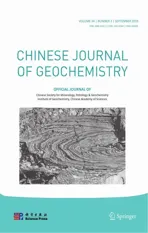Heavy metal(loid)pollution in mine wastes of a Carlin-type gold mine in southwestern Guizhou,China and its environmental impacts
2015-01-17PingLiJunfangZhangJianxuWangZhonggenLi
Ping Li•Junfang Zhang•Jianxu Wang•Zhonggen Li
Heavy metal(loid)pollution in mine wastes of a Carlin-type gold mine in southwestern Guizhou,China and its environmental impacts
Ping Li1•Junfang Zhang2•Jianxu Wang1•Zhonggen Li1
Mercury pollution resulting from artisanal gold mining is a serious environmental problem in many developing countries.In this study,we analyzed heavy metal(loid)contamination in mine wastes from a Carlin-type gold minein southwestern Guizhou,China.Highly elevated levels of As,Hg,Tl,Sb,and Cd—up to 5844,28, 29,581 and 3.0 mg/kg,respectively—were observed in the mine wastes,but no signifcant accumulation of Cr,Ni,Cu, Zn,and Pb was found.The smelting process of gold ores had signifcant impacts on the enrichment of As,Tl,and Hg in the mine wastes.Due to the signifcant metal(loid) pollution in this gold mine,the ecological risks are classifed as‘‘very high.’’Hg and As are the major pollutants with a relative contribution of 55.9%and 24.2%to the risk index,respectively.Phytoremediation could be used to reduce heavy metal contamination and recycle the gold simultaneously.Hg–As–Tl pollution should be considered in gold extraction at Carlin-type gold mines.
Heavy metals·Metalloid·Potential ecological risk assessment·Enrichment factor· Mine waste·Carlin-type gold mine
1 Introduction
China produced the most gold in the world in 2007,and kept this record at least through the following 6 years.Gold output in China increased 11.7%in 2012 with a yield of 403 tonnes(CGA 2013).Gold resources are unevenly distributed in China.Many types of gold ore have been found in northern and eastern China.Primary gold ore occurs mainly in Shandong,Henan,Hebei,Shaanxi,Jilin, and Hubei Provinces;while gold placers are found mainly along the margins of northeastern China,such as Heilongjiang,Shaanxi,Gansu,Sichuan,and Inner Mongolia. Recently,western provinces such as Guizhou and Yunnan have gained a sharp increase in gold production.
In Guizhou Province,gold production has increased since the advent of bacterial pretreatment to extract invisible gold in sulfde minerals a few years ago.Carlin-type gold ore is a typical refractory ore,characterized by low gold grade and high sulfur and arsenic concentrations.Gold usually occurs in these ores as discrete particulates (<0.1 μm in diameter)within sulfde minerals.For Carlintype gold ore,bioleaching is advantageous over other traditional methods(Qiu et al.2012).
Carlin-type gold deposits(also known as sedimenthosted gold deposits)are the largest hydrothermal gold deposits in the world and are widely distributed in the United States and China(Tretbar et al.2000;Hu et al. 2002).The region of southwestern Guizhou,is an important component of the Yunnan–Guizhou–Guangxi‘‘gold triangle’’area.Carlin-type gold deposits in southwestern Guizhou,China,are hosted in late Paleozoic and early Mesozoic sedimentary rocks along the southwest margin of the Precambrian Yangtze craton.The deposits can be classifed as two types,namely the fault type and the stratabound type,based on their occurrence,shape and structuralcontrols(Zhang et al.2003;Xia et al.2012).They have similar characteristics to Carlin-type gold deposits in Nevada,including notable enrichment in As,Sb,Hg,and Tl (Hu et al.2002;Xia et al.2012).
Unfortunately,many modern gold mining practices have led to elevated levels of pollutants in air,soil,and water. Artisanal and small-scale gold mining(ASGM)was the largest anthropogenic source of Hg emission to the air in the world in 2010 at 727 tonnes or 37%of the global anthropogenic emissions(UNEP 2013).ASGM has been recognized as one of the Top 10 Toxic Pollution Problems in 2012 by Blacksmith Institute.The technique is popular in developing countries because of its simple processes and low costs;it accounts for about 20%of global gold production.The Hg pollution resulting from ASGM is a serious environmental problem in South America,China, Russia,Southeast Asia,and Africa(Lacerda and Salomons 1998;Feng et al.2006).In 1996,ASGM was banned in China and dissolution with cyanide(CN)has been widely developed.In this technique,fnely ground high-grade ore is mixed with CN;low-grade ores are stacked into heaps and sprayed with a CN solution.
Carlin-type gold deposits show enrichment in Au,Sb, Hg,Tl,and Ba.This enrichment results from hydrothermal circulation with a temperature of up to 300°C.The associated trace elements are released into the environment during mining and refning processes.This paper evaluates heavy metal and metalloid pollution and their possible sources in Laowanchang gold mine in Guizhou Province,China.The results provide scientifc input to pollution control and remediation efforts in Carlin-type gold mines.
2 Materials and methods
2.1 Study area
The Laowanchang gold mine is located in the south of Qinglong County(Fig.1).The ore is a Carlin-type gold deposit with the characteristic Au–As–Sb–Hg–Tl trace element assemblage.It is considered to be the product of weathering evolution of a primary Carlin-type gold deposit. It formed through the accumulation of ore-forming material by karst collapse,followed by lateralization(Yang and Liu 2003;Yang et al.2004).The granulating-dumpleaching technique was used to extract gold in this mine. The processing techniques included grinding,concentration,dehydration,and pressure oxidation before cyanidation(Fig.2;Ren 2003).The total gold reserve of this mine was 2278 kg,with a grade of 0.5–1.25 g/t.During the period of 1993–2008,signifcant quantities of mine wastes were produced and piled in the mining area.
2.2 Sample collection
In October 2010,49 mine waste and surface soil samples were collected in the study area(Fig.1).The sampling sites can be categorized into fve types:mine wastes in the settling tank(A),mine wastes(B),crude ores(C),corn feld soil(D),and background soil(E).The settling tank was a separation unit separating solids from the waste water.Suspended particles were settled to the bottom of the tank and the waste water was discharged.The corn felds are very close to mine waste heaps.The control site selected for comparison with the polluted sites was located~5 km from the gold mine sites.
Crude ores were collected from different areas and smelted at Laowanchang sites.The mine wastes were heaped in Laowanchang and Hongyan sites.The crude ores were extracted from the land surface and the grasses and trees removed,causing soil erosion in the mining area.
Every sample consisted of a composite of four to fve subsamples within an area of 1 m2.A profle of the mine waste was collected at site QL5,and it was divided into ten depths with an interval of 30 cm.We collected mine ore waste samples at different depths.In the laboratory,the samples were air-dried,ground,and passed through a 100-mesh nylon sieve prior to geochemical analysis.
2.3 Analytical methods
The prepared samples were digested in the mixed acid of HNO3–HF,and Cd,Sb,Tl,Cr,Ni,Cu,Zn,Pb,and Sc concentrations in the digests were determined by Inductively Coupled Plasma Mass Spectroscopy (ICPMS,Element,Finnigan MAT Co)according to the method developed by Qi and Gre´goire(2000).Arsenic concentrations in samples were digested by HNO3–HCl–H2O2and determined by atomic fuorescence spectrometry (AFS-920, Beijing Jitian Instrument Corporation).
Mercury concentrations in the samples were analyzed by the RA-915+Hg analyzer coupled with the PYRO-915+attachment(Lumex Co.,Russia).Au concentrations in the samples were analyzed by aqua regia digestion and atomic absorption spectrometry detection.CN concentrations in the samples were determined by the Pyridine Pyrazolone Spectrophotometric Method(Xu et al.1999) with a limit of detection(LOD)of 0.025 mg/kg.Concentrations below the LOD were assumed to be the LOD in the calculation and assessment.In addition,the pH was determined with a pH meter in 2.5:1(v/m)water/solid suspension.
Quality assurance and quality control consisted of method blanks,duplicates, and certifed referencematerials.Recoveries of certifed reference materials (GBW07405 and GBWE070023)for all elements ranged between 90.2%and 106%(Table 1).The relative percentage difference was<10%for heavy metals and metalloids in duplicate samples.All chemical analyses were carried out in the Institute of Geochemistry,Chinese Academy of Sciences.

Fig.1 Location of the sampling sites in the Laowanchang gold mine, southwestern Guizhou,China

Fig.2 The sketch map of the process of gold smelting in the Laowanchang mine
2.4 Potential ecological risk assessment
Themethodofpotentialecologicalriskassessmentwascreated by Hakanson(1980)and has been widely applied to the pollution assessment of sediment and soil.It integrates concentrationandecologicaltoxicityofdifferentpollutants,andgives a potential ecological risk index as shown in Eq.(1):

Table 1 List of certifed reference materials used in the present study and the results obtained

where RI is the potential ecological risk index;Ei is the potential ecological risk factor for a given pollutant(i);Ti is the‘‘toxic-response’’factor for a given pollutant as calculated by Hakanson(1980),i.e.,Hg=40,Cd=30, As=Tl=Sb=10,Pb=Cu=Ni=5,Cr=2,Zn= 1;and Ci is the ratio of metal(loid)concentration in the sample to the corresponding background level.RI can be divided into four levels:RI<150,low ecological risk;150<RI<300,moderate ecological risk;300<RI<600,considerable ecological risk;and RI>600,very high ecological risk.
2.5 Calculation of enrichment factors
The Enrichment Factor(EF)has been widely used to quantify the extent of human-induced contamination;it is defned as the relative abundance of a chemical element in the environmental media compared with the background (Shotyk et al.2000).EF is calculated according to Eq.(2):

where M is the concentration of the element under consideration and X is the concentration of the chosen reference element.The reference element is conservative, and the most commonly used elements are Al,Fe,Sc,and Ti(Hernandez et al.2003;Abrahim and Parker 2008). In this study,Sc was selected as it is generally considered to be mainly originated from natural sources(rock weathering).
3 Results
3.1 Major elements and pH
The gold ore is composed of SiO2,Fe2O3,Al2O3,and TiO2(Chen 1999)as shown in Table 2.Compared with Guizhou red soil,the gold ore is rich in SiO2and Fe,and depleted in Ca and Mg.This indicates the gold mine originated from a primary Carlin-type gold deposit through strong weathering evolution.The deposit formed through the accumulation of ore-forming material by karst collapse followed by lateralization(Chen 1999;Yang et al.2004).
The pH in the mine wastes and soil samples are listed in Table 3.The pH in the mine waste was higher than that in the crude or soil due to addition of quicklime during the smelting process(Fig.2).

Table 2 Composition of major elements of the gold ore and Guizhou red soil(Data from Chen 1999)(%)
3.2 Heavy metal(loid)concentrations
The background concentrations of heavy metal(loid)s in Guizhou soil and heavy metal(loid)concentrations at the reference site are listed in Table 4.The background levels of As,Hg,Tl,and Cd at the reference site of the study area were comparable with the background levels of these elements in soil in Guizhou.However,the concentration of Sb and Au in soil at the reference site in this study was signifcantly higher than the background concentrations of these elements in soil of Guizhou Province.This might be related to Sb and Au mineralization in this region.
No signifcant accumulation of Cr,Ni,Cu,Zn,and Pb was observed in the mine wastes(Table 3).The maximum concentrations of As,Hg,Tl,Sb,and Cd were 5844,28,29, 581,and 3.0 mg/kg,respectively.The As and Hg concentrations were elevated by three orders of magnitude compared with the background values at the reference site. The maximum concentrations of CN and Au were 4.0 and 4.8 mg/kg,respectively.
Concentrations of selected trace elements differed signifcantly between different types of samples(Fig.3). Among these types,the highest concentrations for As,Hg, Tl,Au,and CN were observed in types A and B.However, for Sb and Cd,the highest concentrations were observed in type C samples,indicating high metal levels in the crude ores related to mineralization.
3.3 Mine waste profle
The concentrations of elements,pH,and organic matter in the profle of mine waste are shown in Fig.4.Sb and Cd concentrations were nearly constant at different depths.Hg,Tl,Au,and CN concentrations varied greatly at different depths,but the overall trend was consistent.
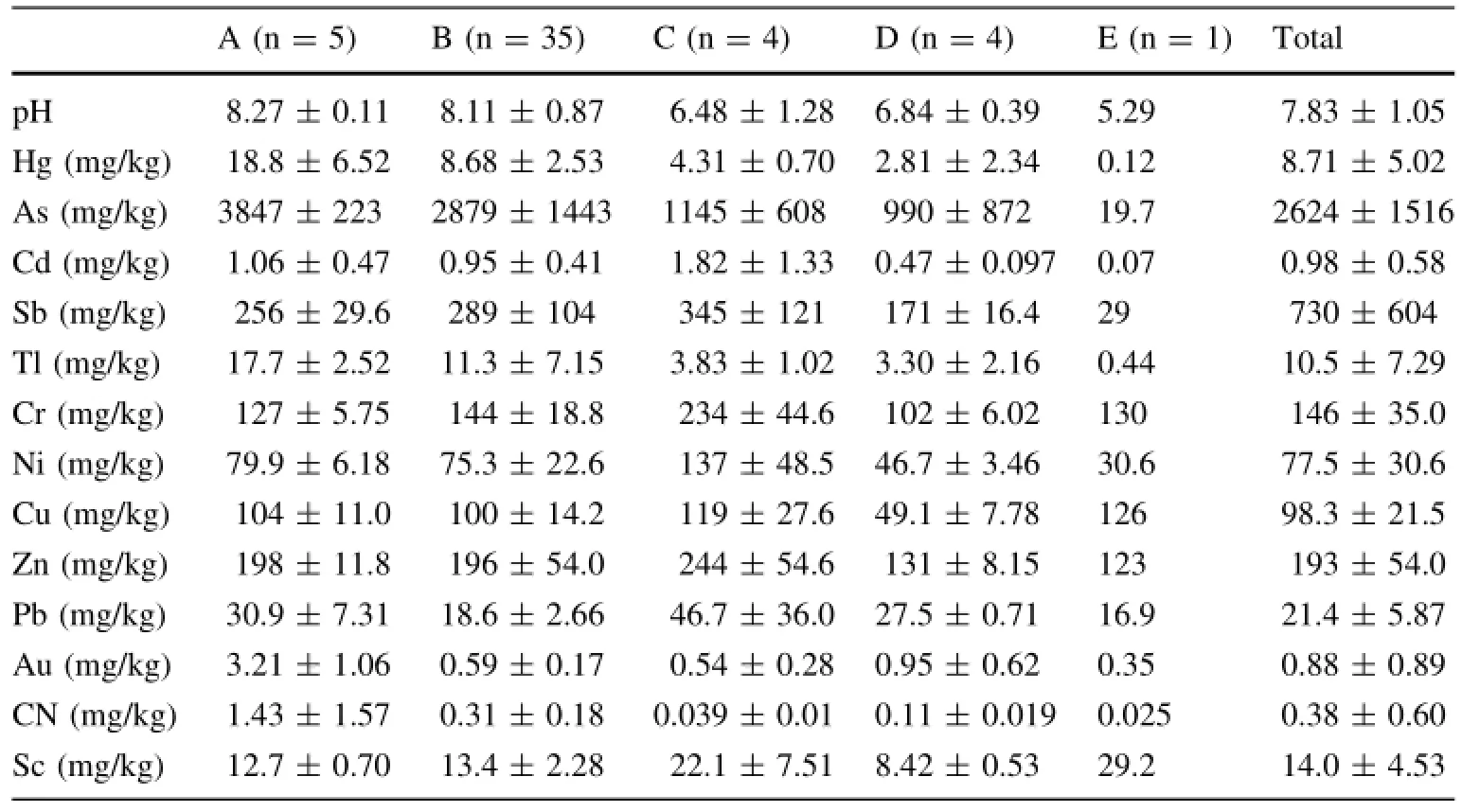
Table 3 Statistics of studied elements and parameters in different types of mine waste (Mean±SD)

Table 4 The heavy metal(loid)concentrations in background soil of Guizhou,soil from control site in the study area,and the national limit levels(mg/kg)
Arsenic concentrations in the profle decreased with depth.Redox potential(Eh)and pH are the most important factors controlling As speciation and mobility.Arsenic is relatively mobile under a reducing environment in contrast to other heavy metals(Smedley and Kinniburgh 2002). Reducing conditions and high pH(8.36–8.70)at the bottom of mine wastes can lead to the desorption of As from mineral oxides and to the reductive dissolution of Fe and Mn oxides.Thus,As can migrate to underground water from mine wastes and its concentrations were notably less in the bottom layer.
4 Discussion
4.1 Risk index
The ecological impacts of heavy metals and metalloids in mine wastes and soils are listed in Table 5.RI for all sample types reached‘‘very high’’levels,indicating serious heavy metal and metalloid pollution in the study area.The average relative contribution from each element,as calculated as the percentage of Ei compared to RI was:Hg 55.9%,As 24.2%,Cd 12.4%,Tl 4.1%,and Sb 2.5%. Average relative contributions from Cr,Ni,Cu,Zn,and Pb were very small(<0.5%).Hg and As are the majorpollutants in this gold mine,and remedial techniques are urgently needed to mitigate the historical pollution before land reclamation.
A comparison of heavy metal pollution in different gold mines in China is shown in Table 6.Due to the widespread use of Hg for gold extraction before 1996 in China,Hg is the major pollutant in most gold mines of China.Other heavy metals(Cd and Cu)were also observed at elevated levels in some gold mines.The ecological risks in the study mine were much higher than other gold mines.Even though amalgamation was not used in this mine,Hg is still the major pollutant in this Carlin-type gold mining area.
4.2 Pollution source analysis
In order to evaluate the impact of the smelting process on the accumulation of heavy metals and metalloids in the mine wastes,trace element concentrations in the crude ore were considered as the background values to calculate EFs. The results are listed in Table 7.The values of EF,using Sc as the reference element,were in the range of 0.9–8.0.The EFs were 0.9 and 1.0 for Cd and 1.4 and 1.3 for Sb, indicating no signifcant enrichment.High EF values were observed for Hg,As,and Tl,with a range of 3.3–8.0.These three elements(Hg,As,and Tl)had accumulatedsignifcantly in the mine wastes of the settling tank through the smelting process,but there was nearly no impact on Cd and Sb from the smelting process.The geochemical behavior of heavy metals and metalloids varied in the smelting process.According to the EF values,the trace elements can be divided into two groups:Hg–As–Tl and Cd–Sb.
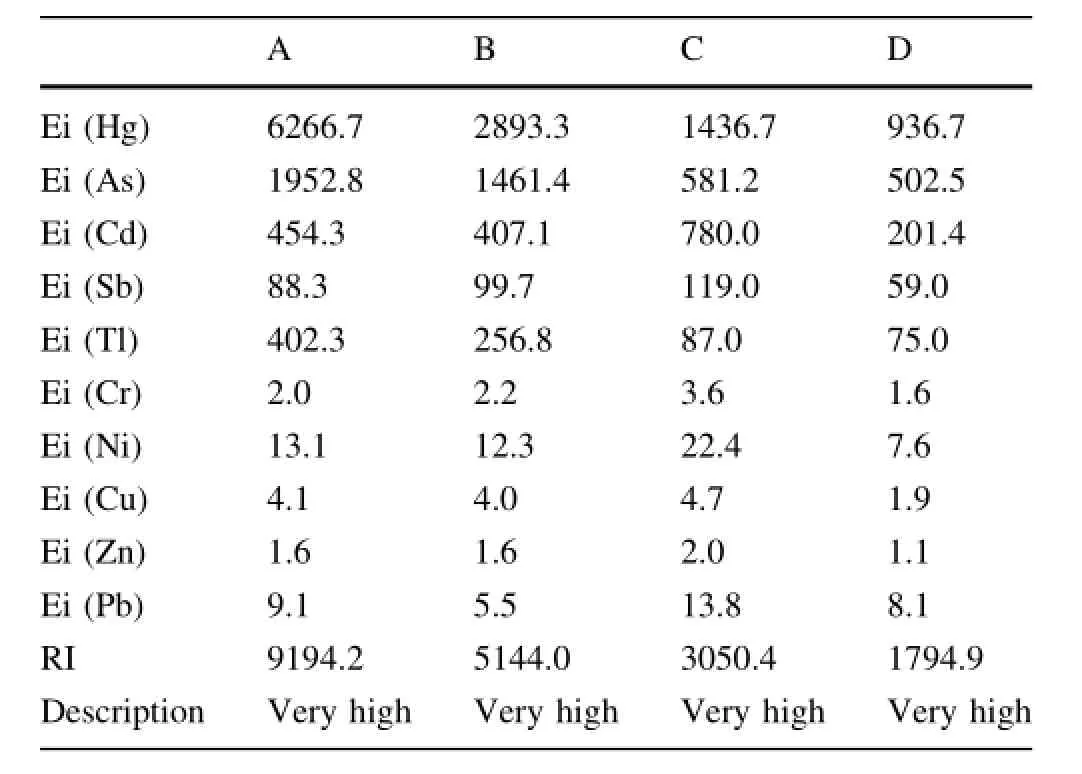
Table 5 Result of potential ecological risk assessment in the study area
The correlation analysis between all trace elements is shown in Table 8.The As,Hg,and Tl concentrations signifcantly correlated with each other(p<0.001);and Cd and Sb signifcantly correlated(p<0.01).According to the correlation factors,the elements can be divided into twogroups:As–Hg–Tl and Cd–Sb.In other words,the results were identical with those of the EF analysis and indicated that the crude ores were the main pollution source and the smelting process caused signifcant enrichment of Hg,As, and Tl in the mine wastes.
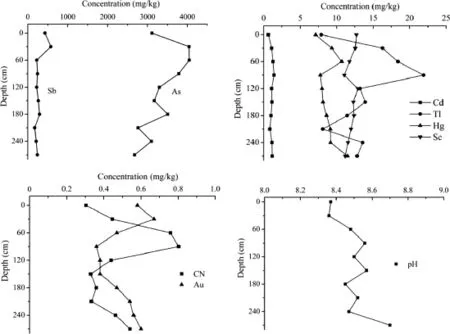
Fig.4 Distribution patterns of trace element concentrations and other parameters in the mine waste profle

Table 6 Comparison of heavy metal pollution in gold mines of China

Table 7 Enrichment factors of mine wastes through smelting process
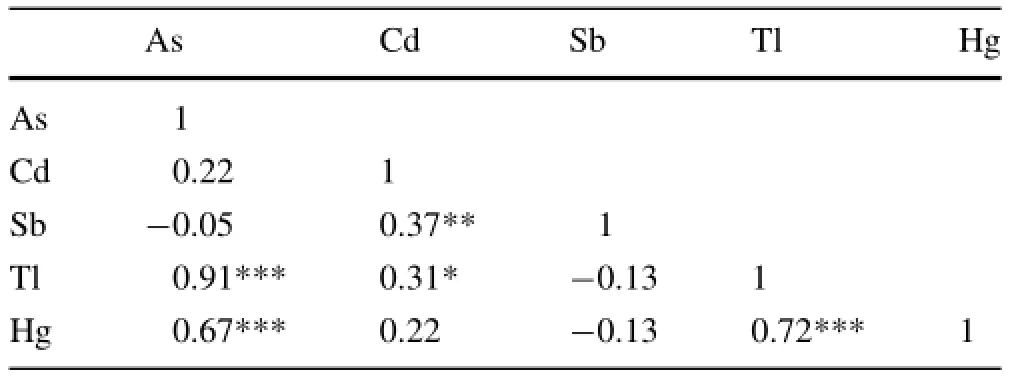
Table 8 Pearson correlations between different trace elements in the samples
4.3 Implications for phytoremediation
This study revealed heavy metal and metalloid(Hg,As,Tl, Cd,and Sb)contamination and gold enrichment in mine wastes.In 1998,Anderson et al.(1998)frst reported harvesting a crop of gold in plants—gold phytomining.The increase in gold prices during recent decades combined with higher gold concentrations in plant tissues and higher biomass yield has made gold phytomining economically feasible(Wilson-Corral et al.2012).Gold phytomining trials in the feld have been reported in the Fazenda Brasileiro gold mine,Brazil(Anderson et al.2005),and in the Magistral mine,Mexico(Wilson-Corral et al.2011).An economic assessment in Mexico indicated the gross proft was US$14,537/ha after subtracting the cost of producing biomass(US$8,330/ha)(Wilson-Corral et al.2012).In addition to gold recovery,hyperaccumulator plants can be used to extract heavy metals.Balancing the cost of phytoremediation and the economic beneft is an important issue.The Laowanchang mine is an ideal site to carry out phytomining and phytoremediation simultaneously.
5 Conclusions
Highly elevated levels of As,Hg,Tl,Sb,and Cd were observed in the mine wastes from a Carlin-type gold mine in southwestern Guizhou,China.The ecological risks all reached the‘‘very high’’level,indicating heavy metal(loid) pollution associated with this gold mine.Hg and As were the major pollutants with relative contributions of 55.9 and 24.2%to RI,respectively.The smelting process of gold ores had signifcant impacts on the enrichment of As,Tl, and Hg in the mine wastes.
AcknowledgmentsThis study was funded by the West Light Foundation of the Chinese Academy of Sciences,and the Social Development Project of Guizhou Province(2012–3044),the Natural Science Foundation of Guizhou Province(2009–2003),and the NationalNaturalScience Foundation ofChina (21007068 and 41373135).
Abrahim GMS,Parker RJ(2008)Assessment of heavy metal enrichment factors and the degree of contamination in Marine Sediments from Tamaki Estuary,Auckland,New Zealand[J]. Environ Monit Assess 136:227–238
Anderson WNC,Brooks RR,Stewart BR,Simcock R(1998) Harvesting a crop of gold in plants[J].Nature 395:553–554
Anderson WNC,Moreno F,Meech J(2005)A feld demonstration of gold phytoextraction technology[J].Miner Eng 18:385–392
CGA(2013)China’s gold production exceeded 400 tons and ranked frst in the world for six consecutive years.China Gold Association, website: http://www.cngold.org.cn/newsinfo. aspx?ID=867.Accessed 8 Aug 2013
Chen L(1999)Geochemistry of macroelements and lateritization of Laowanchang lateritic gold deposits in Qinglong,Guizhou[J]. Guizhou Geol 16:307–314(In Chinese with English abstract)
Chen Y,Ji H,Zhu X,Huang X,Qiao M(2012)Fraction Distribution and risk assessment of heavy metals in soils around the Gold Mine of Detiangou-Qifengcha,Beijing City,China[J].J Agro-Environ Sci 31:2142–2151(In Chinese with English abstract)
Feng X,Dai Q,Qiu G,Li G,He L,Wang D(2006)Gold mining related mercury contamination in Tongguan,Shaanxi Province, PR China[J].Appl Geochem 21:1955–1968
Hakanson L(1980)An ecological risk index for aquatic pollution control:a sediment logical approach[J].Water Res 8:975–1001
He S(1998)Geochemical background of supergene sediments in Guizhou[J].Guizhou Geol 15:149–156(In Chinese with English abstract)
Hernandez L,Probst A,Probst JL,Ulrich E(2003)Heavy metal distribution in some French forest soil,evidence for atmospheric contamination[J].Sci Total Environ 312:195–219
Hu RZ,Su WC,Bi XW,Tu GZ,Hofstra AH(2002)Geology and geochemistry of Carlin-type gold deposits in China[J].Miner Depos 37:378–392
Lacerda LD,Salomons W(1998)Mercury from gold and silver mining:a chemical time bomb?Springer,Berlin
Liang N,Yang L,Dai J,Pang X(2011)Heavy metal pollution in surface water of Linglong gold mining area,China[J].Proced Environ Sci 10:914–917
Qi L,Gre´goire DC(2000)Determination of trace elements in twenty six Chinese geochemistry reference materials by inductively coupled plasma-mass spectrometry[J].Geostand Geoanal Res 24:51–63
Qiu X,Wen J,Wu B,Liu M(2012)Research status about bacterial pretreatment method of Carlin-type gold ore[J].Chin J Rare Metals 36:1002–1009(In Chinese with English abstract)
Ren M(2003)Gold-extracting techniques of granulating and dumpleaching at the Laowanchang gold mine,Qinglong County, Guizhou[J].Guizhou Geol 20:264–269(In Chinese with English abstract)
SEPAC(State Environmental Protection Administration of China), 1995.Chinese Environmental Quality Standard for Soils(GB 15618-1995)
Shotyk W,Blaser P,Grunig A,Cheburkin AK(2000)A new approach for quantifying cumulative,anthropogenic,atmospheric lead deposition using peat cores from bogs:Pb in eight Swiss peat bog profles[J].Sci Total Environ 249:281–295
Smedley PL,Kinniburgh DG(2002)A review of the source, behaviour and distribution of arsenic in natural waters[J].Appl Geochem 17:517–568
Tretbar DR,Arehart GB,Christensen JN (2000)Dating gold deposition in a Carlin-type gold deposit using Rb/Sr methods on the mineral galkhaite[J].Geology 28:947–950
UNEP(2013)Global mercury assessment 2013:sources,emissions, releases and environmental transport.United Nations Environment Programme,Chemicals Branch,Geneva,Switzerland
Wilson-Corral V,Anderson C,Rodriguez-Lopez M,Arenas-Vargas M,Lopez-Perez J(2011)Phytoextraction of gold and copper from mine tailings with Helianthus annuus L.and Kalanchoe serrata L.Miner Eng 24:1488–1494
Wilson-Corral V,Anderson WNC,Rodriguez-Lopez M(2012)Gold phytomining.A review of the relevance of this technology to mineral extraction in the 21st century[J].J Environ Manage 111:249–257
Wu Y,Xu Y,Zhang J,Hu S(2010)Evaluation of ecological risk and primary empirical research on heavy metals in polluted soil over Xiaoqinling gold mining region,Shaanxi,China[J].Trans Nonferrous Met Soc China 20:688–694
Xia Y,Su W,Zhang X,Liu J,(2012)Geochemistry and metallogenic model of Carlin-type gold deposits in Southwest Guizhou Province,China,geochemistry-earth’s system processes,Dr. Dionisios Panagiotaras (Ed.), ISBN: 978-953-51-0586-2, InTech,Available from:http://www.intechopen.com/books/geo chemistry-earth-s-system-processes/geochemistry-and-metallo genicmodel-of-carlin-type-gold-deposits-in-southwest-guizhou-pro vince-china
Xu Y,Li J,Huang R(1999)Study of analysis of estimating the total cyanide in soil[J].Environ Monit China 15:27–29(In Chinese with English abstract)
Yang Y,Liu S(2003)Source of ore-forming materials in Laowanchang gold ore deposit,Guizhou Province,China[J].Acta Miner Sin 23:364–370(In Chinese with English abstract)
Yang J,Wang N(2013)Assessment of potential ecological risk of heavy metals in soils from Jia-Pi-Gou Gold Mine Area,China [J].J Agro-Environ Sci 32:595–600(In Chinese with English abstract)
Yang Y,Liu S,Jin Z(2004)Laterization and its control on gold occurrence in Laowanchang gold deposit,Guizhou Province[J]. Geochimica 33:414–422(In Chinese with English abstract)
Zhang XC,Spiro B,Halls C,Stanley C,Yang KY (2003) Sedimenthosted disseminated gold deposits in southwest Guizhou,PRC:their geological setting and origin in relation to mineralogical,fuid inclusion,and stable-isotope characteristics [J].Int Geol Rev 45:407–470
Received:11 January 2015/Revised:25 March 2015/Accepted:4 May 2015/Published online:14 May 2015
©Science Press,Institute of Geochemistry,CAS and Springer-Verlag Berlin Heidelberg 2015
✉ Ping Li
ping_ligyig@163.com
1State Key Laboratory of Environmental Geochemistry, Institute of Geochemistry,Chinese Academy of Sciences, Guiyang 550002,China
2Guizhou Provincial Key Laboratory of Water Pollution Control and Resource Reuse,Guiyang 550081,China
杂志排行
Acta Geochimica的其它文章
- Sulfur determination by laser ablation high resolution magnetic sector ICP-MS applied to glasses,aphyric lavas, and micro-laminated sediments
- A large carbon pool in lake sediments over the arid/semiarid region,NW China
- Distributional characteristics and sources of elements in soil from typical area of Pearl River Delta economic zone,Guangdong Province,China
- The controls on the composition of biodegraded oils in the Liuhua11-1 Oilfeld,Pearl River Mouth Basin,South China Sea
- Spatial pattern and distribution regularity of soil environmental quality in East China
- Characteristics of biomarker in source rocks of Linxi Formation in Taohaiyingzi region,Zhalute basin
